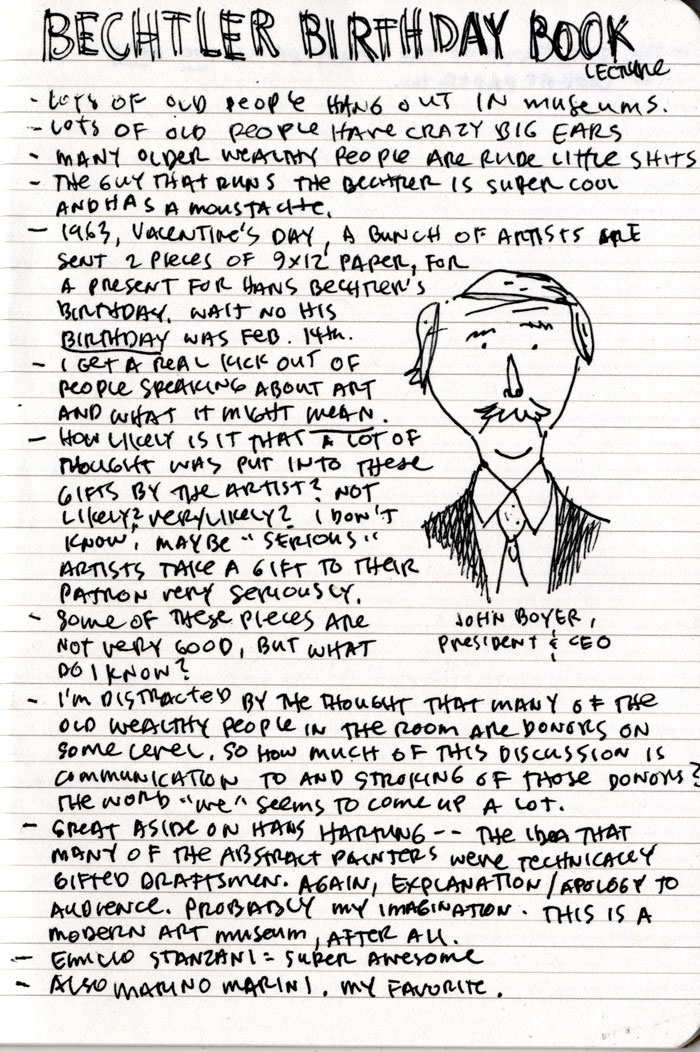REVIEW PROJECT :: The Bechtler Birthday Book
[NOTE: this post is part of a series of reviews, the rules of which are listed in the little image there or here at the initial post in the series. If you are a nervous reader or prone to complaining, please read the rules first!]
So on January 23 (can you tell I'm already behind on reviewing things?) my girlfriend and I went to a lecture at the Bechtler Museum of Modern Art, part of their "Modern Mondays" series of events. The lecture was on the Hans Bechtler "Birthday Book", a collection of pieces commissioned from a number of artists as gifts for patron and collector Hans Bechtler in 1964.
A bit of background: the Bechtler Museum represents a large private collection of modern art amassed by the Bechtler family over 70 years of collecting and patronage. It's a gorgeous building, designed by Mario Botta (who also did the San Franscisco MoMA), and the collection is unique in that it is a collection--rather than just a bunch of paintings in one room, it represents the interests, personal relationshipos, and aesthetic of a family, from the father, Hans Bechtler, down through his children, Andreas and Dany Bechtler.
So anyway--the birthday book was for Hans. Invitations were sent out to a number of artists, along with 2 pieces of 9 x 12 paper. The artists weren't just "who's pretty famous right now?"--it was artists who in most cases had some sort of relationship with Hans himself. The result was a presentation book filled with 27 pieces, presented to Hans on his birthday. Today they're split between the public Bechtler collection (14 of which were on view for this event, along with the book/box itself), and the private collection of Dany Bechtler, who lives in Switzerland.

I've only recently, maybe in the last couple of years, become really interested in modern art, which means I lack a lifetime of thinking and education on the subject: so please pardon my ignorance. I approach things like this with as open a mind as I can manage, because I still have the vestiges of the "that looks like a child drew it" thing that people get with abstract art. This is probably exacerbated by being a cartoonist and thinking about technical concerns and questions of--above all else--legibility in the drawings I make and look at all day.
Which of course, is not the point of abstract art, or at least not in terms of technical concerns. But even so it was hard to view the collection of "birthday book" pieces as being actually significant, except in a historical sense. There were some really interesting pieces, but the group was just.. a group of images, drawings made by a bunch of people for one guy.
But the exhibit, and moreso the lecture, were educational insofar as the idea of the patron's role in the world of art. The dedicated collector, the superfan, the first line of support, both financially and emotionally, for an artist, especially an artist whose work has not yet gained the attention of a larger audience.
We have a similar thing in comics--certain people take a unique pleasure in supporting an artist's work, often by buying original pieces, commissioning new pieces, etc. Not to mention, are active networkers and work to enlarge an artist's audience in non-financial ways as well. And then there's someone like Anne Koyama, who would slap my face if I called her a "patron"--she's a publisher, first and foremost, and a businessperson, even if her business model is based more on her own aesthetic connection to an artist's work than ideas of profit margin. But Anne is an energetic buyer of original art, and a relentless supporter of artists, both those she publishes and those she just loves. And I bet there are dozens of people whose Kickstarter projects Anne has contributed to, often at the highest levels. It's just how she rolls.
Anyway, enough about me and my friends. But I'm very acquainted with the idea of patronage in the comics world, but never really thought about it in the larger art world. Especially in the last century, when the support of the right person at the right time could make an enormous difference in an artist's ability to continue working, not to mention cement a lasting legacy after their deaths. Beyond the making of art, if anyone's going to see it you're going to need someone to notice it eventually.
But the pieces in the collection, while occasionally really brilliant--especially the work of Emilio Stanzani and Marino Marini, as noted in my scribbled notes--weren't as a group very interesting, beyond their historical significance. What was interesting was John Boyer's lecture on the pieces and how they came to be. And what was even more interesting were the people in that lecture: it was mainly older people, overwhelmingly female. There was a 70/30 split between "people making an effort at a new hobby called 'art'" and "fussy-ass rich busybodies with too much time." I loved it. It reminded me of being in church, wondering what was going in everyone's heads; who was listening to the sermon, who was just there out of habit, who had been dragged along by a spouse. And at the Bechtler lecture ("Blechture"? branding opportunity? maybe not), there was at least one old guy who would bark from the corner occasionally with authority, "GREAT POINT JOHN THANK YOU".
I love the Bechtler museum--Charlotte is terrible at culture, and the culture we do have is either super white or super boring or both. So having a high quality art museum in town has been really exciting. And going to lectures with a bunch of older ladies is something I hope we get to do every month.
:: Comment